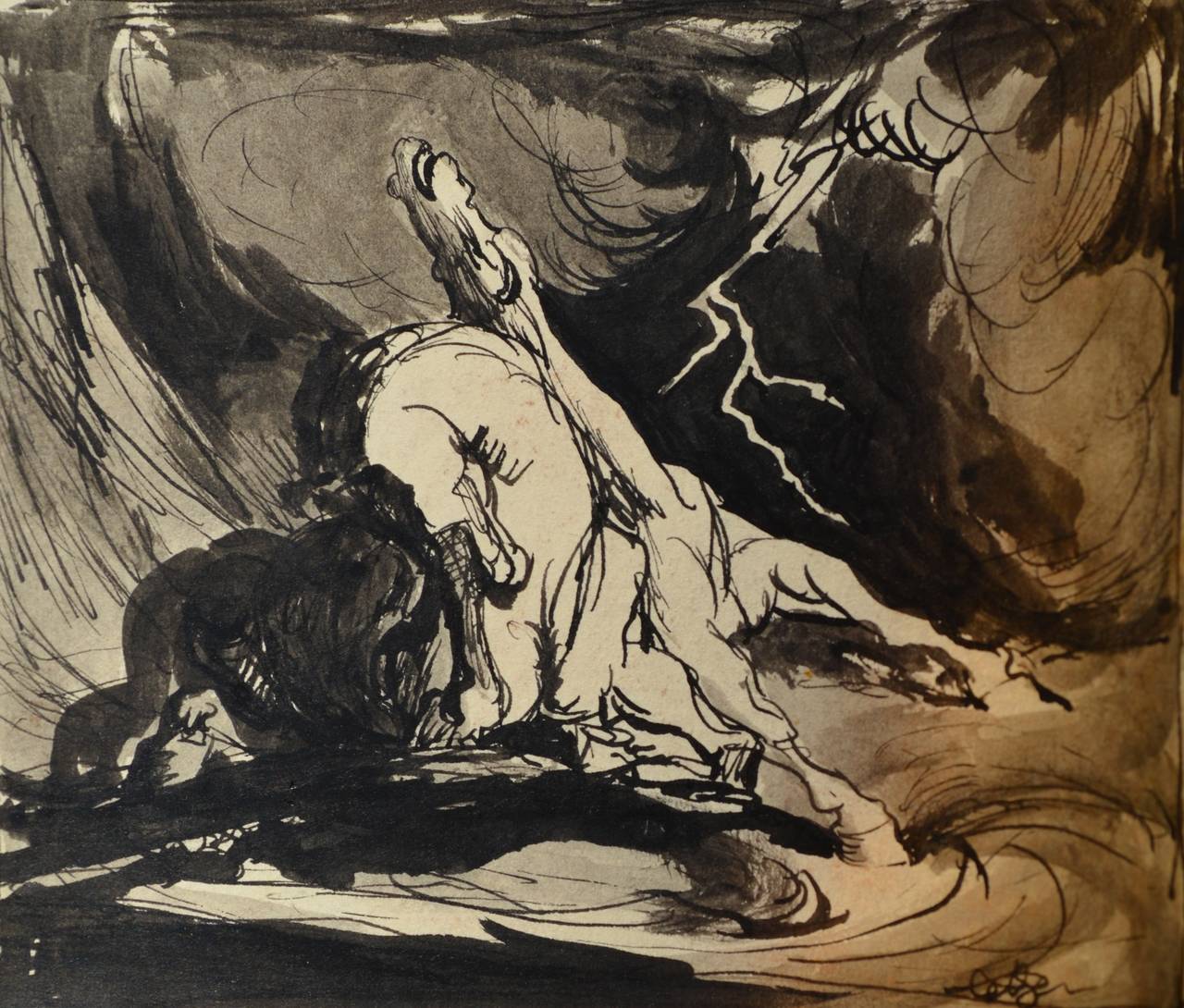Items Similar to Expressionist Figure Study
Want more images or videos?
Request additional images or videos from the seller
1 of 6
Sigmund MenkesExpressionist Figure Study
About the Item
Genre: Expressionist
Subject: Figures
Medium: Ink
Surface: Paper
Dimensions w/Frame: 14 1/4" x 12 1/4"
Zygmunt (Sigmund) Menkes
born in Lviv (Galicia, Austro-Hungarian Empire) Polish painter of Jewish origin, born in 1896 in Lvov, died in 1986 in Riverdale, New York. Member of the École de Paris group in the 1920s and 1930s. From the beginning of 1935 he lived and worked in the United States; he was a representative of the Expressionist Colorism movement.
Menkes began his artistic studies in 1912 at the Industrial School in Lviv. At the same time he worked as a restorer of rural churches. Between 1919 and 1922 he supplemented his studies at Krakow's Academy of Fine Arts and in 1922 expanded on this education and broadened his artistic skills in the private studio of Alexander Archipenko in Berlin. In 1923 Menkes settled in Paris, where he became a member of the École de Paris - a community that was primarily made up of artists hailing from Central and Eastern Europe who rented inexpensive studios in the "La Ruche" building in the Montparnasse district. Menkes developed close friendships with Eugeniusz Zak and Marc Chagall. Two years later, Menkes made the decision to settle permanently in France. He participated in a series of the city's salons, including the Salon d'Automne (1924, 1925, 1927), the Salon des Independants (1925-1928), and Tuileries Salon (1928, 1929, 1931, 1938). He presented his works in a number of Parisian galleries, among them, the Bernheim, de France, and Le Portique. In 1930 the artist traveled to the United States to present his work in Cleveland and New York. He also exhibited his paintings in Canada and England. He visited Poland frequently, spent time in Berlin in 1928, and toured Spain with Artur Nacht-Samborski in 1935, moving to the United States the same year.
In 1936 Menkes had his first solo exhibition in New York at the Sullivan Gallery on 57th Street. He also worked with the Associated American Artists Gallery and the French Art Gallery, and for years was a lecturer at the Art Students League. Solo exhibitions of his work were organized by the Galerie Le Portique in Paris (1928), the Friends of Fine Arts Society in Lviv (1930), and at the Jewish Society for Support of the Fine Arts in Warsaw (1931). In Poland the artist was a member of groups with a Coloristic orientation, including Nowa Generacja (New Generation) and Zwornik (Keystone), participating in their exhibitions in Lviv (1932, 1935) and Warsaw (1935, 1938). Menkes received a series of important distinctions for his work, including the Carol H. Beck Medal of the Pennsylvania Academy of Fine Arts (Philadelphia, 1943), the Gold Medal of the Corcoran Gallery (Washington, D.C., 1947), the Andrew Carnegie Award of the National Academy of Design (New York, 1955), and the Alfred Jurzykowski Award (New York, 1967).
Menkes's repertoire included figural compositions, portraits, nudes, still lifes, and landscapes. Early in his career his paintings exhibited a Fauvist aesthetic. Menkes's creative stance was especially strongly influenced by the work of Henri Matisse. Women depicted in interiors were a frequent motif; their approximated shapes were surrounded by fluid, bending contour lines that at times broke free of the color areas they surrounded. There was a decorative value in his canvasses, deriving from the inclusion of various fabric and wallpaper designs in the composition. Menkes also frequently painted scenes from the lives of the Jewry, depicting religious rituals and rabbis penetrating the words of the Torah. With time he intensified the expressiveness of his paintings, using only color patches to build forms, placing paint on canvas quickly and spontaneously. The artist's signature, signed with vigor in vermilion red, was also an important element in the structure of his compositions. Menkes's works of the late 1920s and the 1930s are compared with Chaim Soutine's Expressionistic formulas of representation. The artist drew his iconography from the Bible, saturating his religious scenes with nostalgia (Ecce Homo). His landscapes, painted in provincial towns and the mountains of southern France, emanate sensuality and demonstrate the artist's extreme sensitivity for the qualities of color and light. Menkes also created a moving series of World War II paintings depicting Jews enclosed in the Warsaw Ghetto and murdered there by the Nazis. These works were distinct for their washed out dominant blues and grays. In time the artist began to paint increasingly complicated configurations of lines, thickened line configurations, and richly textured planes. His expansive still lifes and interior scenes - often depicting the artist's studio in Riverdale, New York - were composed of balanced, multi-directional configurations of lines. Figures and objects were melded ever more precisely with backgrounds, while his color schemes, dominated by hues of blue, black and white, evoked nostalgia. Lively accents were restricted to small patches of pink and yellow. In his later works, which bordered on abstract allusions, we encounter a radical turn towards geometric forms painted in a range of intense, strong, contrasting colors. In addition to painting oils on canvas, Menkes produced gouaches, watercolors, and drawings. He also created a series of sculptures, primarily during a prolonged visit to Italy with Jacques Lipchitz.
The work of Mr. Menkes, an Expressionist, won many awards and hangs in major art institutions and private collections, including the recently closed Museum of the Jeu de Paume in Paris; the Philadelphia Museum of Art; the Whitney Museum in Manhattan; the Wichita (Kan.) Museum; the Newark Museum; the Corcoran Museum in Washington; the Cranbrook Academy in Detroit; the Jewish Museum in Manhattan; the Betsalel Museum in Jerusalem, and the Tel Aviv Museum.
Among the awards he received were the Clark Prize of the Corcoran Gallery, in 1941; the Carol H. Beck Medal of the Pennsylvania Academy, in Philadelphia, in 1943; the Andrew Carnegie award from the National Academy of Design, in Manhattan, in 1955, and the National Academy award for foreign painters, in 1963.
- Creator:Sigmund Menkes (1896 - 1986, American, Polish)
- Dimensions:Height: 14.25 in (36.2 cm)Width: 12.25 in (31.12 cm)
- Medium:
- Movement & Style:
- Period:
- Condition:frame has some wear.
- Gallery Location:Surfside, FL
- Reference Number:1stDibs: LU38211809392
About the Seller
4.9
Platinum Seller
These expertly vetted sellers are 1stDibs' most experienced sellers and are rated highest by our customers.
Established in 1995
1stDibs seller since 2014
1,548 sales on 1stDibs
Typical response time: 1 hour
- ShippingRetrieving quote...Ships From: Surfside, FL
- Return PolicyA return for this item may be initiated within 3 days of delivery.
More From This SellerView All
- Expressionist Color Drawing Cobalt Glass Vintage Frame Modernist Ben Zion WPABy Ben-Zion WeinmanLocated in Surfside, FLExpressionist ink and pastel crayon drawing of flowers in vase. Framed in a vintage cobalt blue glass original frame Hand signed and dated Framed it measures 13.5 X 10.5 The actual paper is 7.5 X 5.5 Born in 1897, Ben-Zion Weinman celebrated his European Jewish heritage in his visual works as a sculptor, painter, and printmaker. Influenced by Spinoza, Knut Hamsun, and Wladyslaw Reymont, as well as Hebrew literature, Ben-Zion wrote poetry and essays that, like his visual work, attempt to reveal the deep “connection between man and the divine, and between man and earth.” An emigrant from the Ukraine, he came to the US in 1920. He wrote fairy tales and poems in Hebrew under the name Benzion Weinman, but when he began painting he dropped his last name and hyphenated his first, saying an artist needed only one name. Ben-Zion was a founding member of “The Ten: An Independent Group” The Ten” a 1930’s avant-garde group, Painted on anything handy. Ben-Zion often used cabinet doors (panels) in his work. Other members of group included Ilya Bolotowsky, Lee Gatch, Adolph Gottlieb, Louis Harris, Yankel Kufeld, Marcus Rothkowitz (later known as Mark Rothko), Louis Schanker, and Joseph Solman. The Art of “The Ten” was generally described as expressionist, as this style offered the best link between modernism and social art. Their exhibition at the Mercury Gallery in New York held at the same time as the Whitney Annual Exhibition of Contemporary American Painting, included a manifesto concentrating on aesthetic questions and criticisms of the conservative definition of modern art imposed by the Whitney. Ben-Zion’s work was quickly noticed. The New York Sun said he painted “furiously” and called him “the farthest along of the lot.” And the triptych, “The Glory of War,” was described by Art News as “resounding.” By 1939, The Ten disbanded because most of the members found individual galleries to represent their work. Ben-Zion had his first one-man show at the Artist’s Gallery in Greenwich Village and J.B. Neumann, the highly esteemed European art dealer who introduced Paul Klee, (among others) to America, purchased several of Ben-Zion’s drawings. Curt Valentin, another well-known dealer, exhibited groups of his drawings and undertook the printing of four portfolios of etchings, each composed of Ben-Zion’s biblical themes. He worked as a WPA artist. Ben-Zion’s work is represented in many museums throughout the country including the Metropolitan, the Whitney, and the Museum of Modern Art in New York, the Art Institute of Chicago, the Philadelphia Museum of Art and the Phillips Collection, Washington. The Jewish Museum in New York opened in 1948 with a Ben-Zion exhibition. Ben-Zion consistently threaded certain subject matter—nature, still life, the human figure, the Hebrew Bible, and the Jewish people—into his work throughout his life. "In all his work a profound human feeling remains. Sea and sky, even sheaves of wheat acquire a monolithic beauty and simplicity which delineates the transient as a reflection of the eternal. This sensitive inter- mingling of the physical and metaphysical is one of the most enduring features of Ben-Zion's works." (Excerpt from Stephen Kayser, “Biblical Paintings,” The Jewish Museum Catalogue, 1952). Mystical Imprints: Marc Chagall, Ben-Zion, and Ben Shahn presents the print work of three prominent 20th century Jewish artists born in the Russian Empire. Among these seventy pieces are etchings and lithographs from Chagall’s Bible series...Category
1950s Expressionist Still-life Drawings and Watercolors
MaterialsPaper, Oil Crayon, Pastel, Ink
- Pastel, Ink Drawing Rocks And Cloud Landscape Jewish American Modernist WPABy Ben-Zion WeinmanLocated in Surfside, FLMiniature Landscape Provenance: Virginia Field, Arts administrator; New York, N.Y. Assistant director for Asia House gallery. (she was friends with John von Wicht and Andy Warhol) Born in 1897, Ben-Zion Weinman celebrated his European Jewish heritage in his visual works as a sculptor, painter, and printmaker. Influenced by Spinoza, Knut Hamsun, and Wladyslaw Reymont, as well as Hebrew literature, Ben-Zion wrote poetry and essays that, like his visual work, attempt to reveal the deep “connection between man and the divine, and between man and earth.” An emigrant from the Ukraine, he came to the US in 1920. He wrote fairy tales and poems in Hebrew under the name Benzion Weinman, but when he began painting he dropped his last name and hyphenated his first, saying an artist needed only one name. Ben-Zion was a founding member of “The Ten: An Independent Group” The Ten” a 1930’s avant-garde group, Painted on anything handy. Ben-Zion often used cabinet doors (panels) in his work. Other members of group included Ilya Bolotowsky, Lee Gatch, Adolf Gottlieb, Louis Harris, Yankel Kufeld, Marcus Rothkowitz (later known as Mark Rothko), Louis Schanker, and Joseph Solman. The Art of “The Ten” was generally described as expressionist, as this style offered the best link between modernism and social art. Their exhibition at the Mercury Gallery in New York held at the same time as the Whitney Annual Exhibition of Contemporary American Painting, included a manifesto concentrating on aesthetic questions and criticisms of the conservative definition of modern art imposed by the Whitney. Ben-Zion’s work was quickly noticed. The New York Sun said he painted “furiously” and called him “the farthest along of the lot.” And the triptych, “The Glory of War,” was described by Art News as “resounding.” By 1939, The Ten disbanded because most of the members found individual galleries to represent their work. Ben-Zion had his first one-man show at the Artist’s Gallery in Greenwich Village and J.B. Neumann, the highly esteemed European art dealer who introduced Paul Klee, (among others) to America, purchased several of Ben-Zion’s drawings. Curt Valentin, another well-known dealer, exhibited groups of his drawings and undertook the printing of four portfolios of etchings, each composed of Ben-Zion’s biblical themes. Ben-Zion’s work is represented in many museums throughout the country including the Metropolitan, the Whitney, and the Museum of Modern Art in New York, the Art Institute of Chicago, the Philadelphia Museum of Art and the Phillips Collection, Washington. The Jewish Museum in New York opened in 1948 with a Ben-Zion exhibition. “Ben-Zion has his hands on the pulse of the common man and his natural world” As he emerged as an artist Ben-Zion never lost his gift for presenting the ordinary in ways that are vital, fresh and filled with emotions that are somber and exhilarating, joyous and thoughtful, and ultimately, filled with extraordinary poetic simplicity. Ben-Zion consistently threaded certain subject matter—nature, still life, the human figure, the Hebrew Bible, and the Jewish people—into his work throughout his life. "In all his work a profound human feeling remains. Sea and sky, even sheaves of wheat acquire a monolithic beauty and simplicity which delineates the transient as a reflection of the eternal. This sensitive inter- mingling of the physical and metaphysical is one of the most enduring features of Ben-Zion's works." (Excerpt from Stephen Kayser, “Biblical Paintings,” The Jewish Museum Catalogue, 1952). Along with ben Shahn, William Gropper, Chaim Gross and Abraham Rattner he was an influential mid century Jewish American...Category
Mid-20th Century Expressionist Landscape Drawings and Watercolors
MaterialsPastel, Ink, Watercolor
- Abstract Drawing Watercolor Painting Totem Column Jewish American Modernist WPABy Ben-Zion WeinmanLocated in Surfside, FLMiniature Abstract Totem. Signed with initials. Provenance: Virginia Field, Arts administrator; New York, N.Y. Assistant director for Asia House gallery. (she was friends with John von Wicht and Andy Warhol) Born in 1897, Ben-Zion Weinman celebrated his European Jewish heritage in his visual works as a sculptor, painter, and printmaker. Influenced by Spinoza, Knut Hamsun, and Wladyslaw Reymont, as well as Hebrew literature, Ben-Zion wrote poetry and essays that, like his visual work, attempt to reveal the deep “connection between man and the divine, and between man and earth.” An emigrant from the Ukraine, he came to the US in 1920. He wrote fairy tales and poems in Hebrew under the name Benzion Weinman, but when he began painting he dropped his last name and hyphenated his first, saying an artist needed only one name. Ben-Zion was a founding member of “The Ten: An Independent Group” The Ten” a 1930’s avant-garde group, Painted on anything handy. Ben-Zion often used cabinet doors (panels) in his work. Other members of group included Ilya Bolotowsky, Lee Gatch, Adolf Gottlieb, Louis Harris, Yankel...Category
Mid-20th Century Expressionist Abstract Drawings and Watercolors
MaterialsInk, Watercolor
- Original German Expressionist Drawing Ernst Ludwig Kirchner Women DancingBy Ernst Ludwig KirchnerLocated in Surfside, FLErnst Ludwig Kirchner ( Germany 1880-1938 ) Expressionist Female Women Dancing Mixed Media on Paper Drawing or Painting Expressionism Dimensions: 20" L 16" H in This bore a sticker from Christies auction house and another collection sticker verso but they have been inadvertently removed. I do have the photo. Ernst Ludwig Kirchner (1880 – 1938) was a German expressionist painter and printmaker and one of the founders of the artists group Die Brücke or "The Bridge", a key group leading to the foundation of Expressionism in 20th-century art. He volunteered for army service in the First World War, but soon suffered a breakdown and was discharged. His work was branded as "Entartete Kunst" or "degenerate" by the Nazis in 1933, and in 1937 more than 600 of his works were sold or destroyed. Ernst Ludwig Kirchner was born in Aschaffenburg, Bavaria. His parents were of Prussian descent and his mother was a descendant of the Huguenots, a fact to which Kirchner often referred. As Kirchner's father searched for a job, the family moved frequently and Kirchner attended schools in Frankfurt and Perlen until his father earned the position of Professor of Paper Sciences at the College of technology in Chemnitz, where Kirchner attended secondary school. Although Kirchner's parents encouraged his artistic career they also wanted him to complete his formal education so in 1901, he began studying architecture at the Königliche Technische Hochschule (royal technical university) of Dresden. The institution provided a wide range of studies in addition to architecture, such as freehand drawing, perspective drawing and the historical study of art. While in attendance, he became close friends with Fritz Bleyl, whom Kirchner met during the first term. They discussed art together and also studied nature, having a radical outlook in common. Kirchner continued studies in Munich from 1903 to 1904, returning to Dresden in 1905 to complete his degree. In 1905, Kirchner, along with Bleyl and two other architecture students, Karl Schmidt-Rottluff and Erich Heckel, founded the artists group Die Brücke ("The Bridge") later to include Emil Nolde, Max Pechstein and Otto Mueller. From then on, he committed himself to art. The group aimed to eschew the prevalent traditional academic style and find a new mode of artistic expression, which would form a bridge (hence the name) between the past and the present. They responded both to past artists such as Albrecht Dürer, Matthias Grünewald and Lucas Cranach the Elder, as well as contemporary international avant-garde movements. As part of the affirmation of their national heritage, they revived older media, particularly woodcut or woodblock prints. Kirchner's studio became a venue which overthrew social conventions to allow casual love-making and frequent nudity. Group life-drawing sessions took place using nude models from the social circle, rather than professionals, and choosing quarter-hour poses to encourage spontaneity. In 1911, he moved to Berlin, where he founded a private art school, MIUM-Institut, in collaboration with Max Pechstein with the aim of promulgating "Moderner Unterricht im Malen" (modern teaching of painting). This was not a success and closed the following year, when he also began a relationship with Erna Schilling that lasted the rest of his life. In 1917, at the suggestion of Eberhard Grisebach [de], Helene Spengler invited Kirchner to Davos where he viewed an exhibition of Ferdinand Hodler paintings. "When I was leaving, I thought of Vincent Van Gogh's fate and thought that it would be his as well, sooner or later. Only later will people understand and see how much he has contributed to painting". In 1921 Kirchner visited Zurich at the beginning of May and met the dancer, Nina Hard, whom he invited back to Frauenkirch (despite Erna's objections). Nina Hard would become an important model for Kirchner and would be featured in many of his works. Kirchner began creating designs for carpets which were then woven by Lise Gujer. In 1925, Kirchner became close friends with fellow artist, Albert Müller...Category
Early 20th Century Expressionist Figurative Drawings and Watercolors
MaterialsInk, Paper
- Expressionist Ink, Pastel, Crayon Drawing Jewish American Modernist Ben Zion WPABy Ben-Zion WeinmanLocated in Surfside, FLExpressionist ink and pastel crayon drawing of beans (carobs, flowers?) in pods Hand signed. Born in 1897, Ben-Zion Weinman celebrated his European Jewish heritage in his visual works as a sculptor, painter, and printmaker. Influenced by Spinoza, Knut Hamsun, and Wladyslaw Reymont, as well as Hebrew literature, Ben-Zion wrote poetry and essays that, like his visual work, attempt to reveal the deep “connection between man and the divine, and between man and earth.” An emigrant from the Ukraine, he came to the US in 1920. He wrote fairy tales and poems in Hebrew under the name Benzion Weinman, but when he began painting he dropped his last name and hyphenated his first, saying an artist needed only one name. Ben-Zion was a founding member of “The Ten: An Independent Group” The Ten” a 1930’s avant-garde group, Painted on anything handy. Ben-Zion often used cabinet doors (panels) in his work. Other members of group included Ilya Bolotowsky, Lee Gatch, Adolph Gottlieb, Louis Harris, Yankel Kufeld, Marcus Rothkowitz (later known as Mark Rothko), Louis Schanker, and Joseph Solman. The Art of “The Ten” was generally described as expressionist, as this style offered the best link between modernism and social art. Their exhibition at the Mercury Gallery in New York held at the same time as the Whitney Annual Exhibition of Contemporary American Painting, included a manifesto concentrating on aesthetic questions and criticisms of the conservative definition of modern art imposed by the Whitney. Ben-Zion’s work was quickly noticed. The New York Sun said he painted “furiously” and called him “the farthest along of the lot.” And the triptych, “The Glory of War,” was described by Art News as “resounding.” By 1939, The Ten disbanded because most of the members found individual galleries to represent their work. Ben-Zion had his first one-man show at the Artist’s Gallery in Greenwich Village and J.B. Neumann, the highly esteemed European art dealer who introduced Paul Klee, (among others) to America, purchased several of Ben-Zion’s drawings. Curt Valentin, another well-known dealer, exhibited groups of his drawings and undertook the printing of four portfolios of etchings, each composed of Ben-Zion’s biblical themes. He worked as a WPA artist. Ben-Zion’s work is represented in many museums throughout the country including the Metropolitan, the Whitney, and the Museum of Modern Art in New York, the Art Institute of Chicago, the Philadelphia Museum of Art and the Phillips Collection, Washington. The Jewish Museum in New York opened in 1948 with a Ben-Zion exhibition. Ben-Zion consistently threaded certain subject matter—nature, still life, the human figure, the Hebrew Bible, and the Jewish people—into his work throughout his life. "In all his work a profound human feeling remains. Sea and sky, even sheaves of wheat acquire a monolithic beauty and simplicity which delineates the transient as a reflection of the eternal. This sensitive inter- mingling of the physical and metaphysical is one of the most enduring features of Ben-Zion's works." (Excerpt from Stephen Kayser, “Biblical Paintings,” The Jewish Museum Catalogue, 1952). Mystical Imprints: Marc Chagall, Ben-Zion, and Ben Shahn presents the print work of three prominent 20th century Jewish artists born in the Russian Empire. Among these seventy pieces are etchings and lithographs from Chagall’s Bible series...Category
Mid-20th Century Expressionist Still-life Drawings and Watercolors
MaterialsPaper, Oil Crayon, Pastel, Ink
- Expressionist Miniature Drawing Wheat Stalks American Modernist Ben Zion WPABy Ben-Zion WeinmanLocated in Surfside, FLExpressionist ink drawing of wheat stalks There is an inscription "Happy New Year" on verso Hand signed Framed it measures 7.75 X 5.75 The actual paper is 3 X 3.5 Born in 1897, Ben-Zion Weinman celebrated his European Jewish heritage in his visual works as a sculptor, painter, and printmaker. Influenced by Spinoza, Knut Hamsun, and Wladyslaw Reymont, as well as Hebrew literature, Ben-Zion wrote poetry and essays that, like his visual work, attempt to reveal the deep “connection between man and the divine, and between man and earth.” An emigrant from the Ukraine, he came to the US in 1920. He wrote fairy tales and poems in Hebrew under the name Benzion Weinman, but when he began painting he dropped his last name and hyphenated his first, saying an artist needed only one name. Ben-Zion was a founding member of “The Ten: An Independent Group” The Ten” a 1930’s avant-garde group, Painted on anything handy. Ben-Zion often used cabinet doors (panels) in his work. Other members of group included Ilya Bolotowsky, Lee Gatch, Adolph Gottlieb, Louis Harris, Yankel Kufeld, Marcus Rothkowitz (later known as Mark Rothko), Louis Schanker, and Joseph Solman. The Art of “The Ten” was generally described as expressionist, as this style offered the best link between modernism and social art. Their exhibition at the Mercury Gallery in New York held at the same time as the Whitney Annual Exhibition of Contemporary American Painting, included a manifesto concentrating on aesthetic questions and criticisms of the conservative definition of modern art imposed by the Whitney. Ben-Zion’s work was quickly noticed. The New York Sun said he painted “furiously” and called him “the farthest along of the lot.” And the triptych, “The Glory of War,” was described by Art News as “resounding.” By 1939, The Ten disbanded because most of the members found individual galleries to represent their work. Ben-Zion had his first one-man show at the Artist’s Gallery in Greenwich Village and J.B. Neumann, the highly esteemed European art dealer who introduced Paul Klee, (among others) to America, purchased several of Ben-Zion’s drawings. Curt Valentin, another well-known dealer, exhibited groups of his drawings and undertook the printing of four portfolios of etchings, each composed of Ben-Zion’s biblical themes. He worked as a WPA artist. Ben-Zion’s work is represented in many museums throughout the country including the Metropolitan, the Whitney, and the Museum of Modern Art in New York, the Art Institute of Chicago, the Philadelphia Museum of Art and the Phillips Collection, Washington. The Jewish Museum in New York opened in 1948 with a Ben-Zion exhibition. Ben-Zion consistently threaded certain subject matter—nature, still life, the human figure, the Hebrew Bible, and the Jewish people—into his work throughout his life. "In all his work a profound human feeling remains. Sea and sky, even sheaves of wheat acquire a monolithic beauty and simplicity which delineates the transient as a reflection of the eternal. This sensitive inter- mingling of the physical and metaphysical is one of the most enduring features of Ben-Zion's works." (Excerpt from Stephen Kayser, “Biblical Paintings,” The Jewish Museum Catalogue, 1952). Mystical Imprints: Marc Chagall, Ben-Zion, and Ben Shahn presents the print work of three prominent 20th century Jewish artists born in the Russian Empire. Among these seventy pieces are etchings and lithographs from Chagall’s Bible series...Category
1950s Expressionist Still-life Drawings and Watercolors
MaterialsInk
You May Also Like
- Seated WomanBy Jules PascinLocated in New York, NYSeated Woman by Jules Pascin (1885-1930) Pen and ink on paper 6 ½ x 6 inches unframed (16.51 x 15.24 cm) 14 x 13 inches framed (35.56 x 33.02 cm) Inscribed (Pascin Estate 81C) on bot...Category
Early 20th Century Expressionist Figurative Drawings and Watercolors
MaterialsInk
- Self PortraitBy Lester JohnsonLocated in New York, NYLester Johnson Self Portrait 1969 drawn with ink, crayon, and spray enamel on paper. Measuring 14 by 11 inches, this drawing was recently professionally framed.Category
1960s Expressionist Figurative Drawings and Watercolors
MaterialsEnamel
- Une Danse, Original Work on Paper, Ink, AcrylicLocated in AIX-EN-PROVENCE, FRAcrylic, Ink, Pastel and collage on paper - Original Work on Paper. The work is in very good condition and is signed lower Right "Patricia R.". Unfortunately we have no further info...Category
1990s Expressionist Figurative Drawings and Watercolors
MaterialsPastel, Archival Ink, Acrylic
- Prize Blade 1, abstract male nude, expressionist brushwork, dark, monochromaticBy Tom BennettLocated in Brooklyn, NYMonotype Dramatic imagery from Tom Bennett’s series of monotypes, blending surrealistic mindscapes with stark realism About Tom Bennett: With quick brushstrokes, Tom Bennett creates representational images of human figures and animals, emphasizing movement in a manner reminiscent of Lucien Freud, Edgar Degas and the photographer Eadweard Muybridge. Elongated and blurry, the horse racing up a hill (Canter Fritz, 2002) and the sinister cat landing a leap (Chien Blanc, 1998) elicit a sense of foreboding enhanced by Bennett’s somber palette; his female figures too reflect a grim sense of humor with their distorted nude bodies. The face of Untitled Figure (1997), for example, is obscured by layers of dark paint. Classically trained as a painter, he initially worked in oil on canvas but discovered that monotype printing enabled him to “literally push the image around,” creating an essential element of motion. To overcome the limited scale of monotypes, however, he switched to painting on slick-surfaced plastic. Tom Bennett’s practice is rooted in the classical tradition where painting and drawing from life is highly regarded. Bennett’s work is heavily influenced by Francis Bacon, Frank Auberbauch and foremost his father, Harry Bennett, who was also an artist. Tom’s time living abroad in Spain and traveling through Eastern Europe and Africa provided the artistic freedom to explore many of the techniques and subject matter that continue to define his practice. Bennett was born and raised in Connecticut. His mediums include monotypes, oil on paper, canvas or styrene board. In a technique that Tom started over 4 years ago, several of his monotypes have been painted over with oil paint using a palette knife, brush, or his fingers to re-purpose the underlying image. These works are a testament to Bennett’s ability to quickly and concisely compose an image with expressive brush strokes, foreshortened figures and expertly rendered light. Tom’s work has been featured in group and solo exhibitions worldwide. Bennett lives and works in Brooklyn, New York. He is currently represented by Tabla Rasa...Category
2010s Expressionist Nude Drawings and Watercolors
MaterialsArchival Ink, Archival Paper, Monotype
- Planting the StakeBy Gustav RehbergerLocated in West Hollywood, CAWe are proud to present a just arrived series of original pen and ink and ink wash drawings by Austrian/American artist Gustav Rehberger. These works were acquired directly from the ...Category
1970s Expressionist Figurative Drawings and Watercolors
MaterialsInk
- Man and the MountainBy Gustav RehbergerLocated in West Hollywood, CAWe are proud to present a just arrived series of original pen and ink and ink wash drawings by Austrian/American artist Gustav Rehberger. These works were acquired directly from the ...Category
1970s Expressionist Figurative Drawings and Watercolors
MaterialsInk





